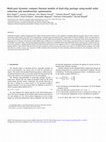Papers by Lorenzo Codecasa

Electronic designers continuously strive to supply more power in a smaller volume and obviously w... more Electronic designers continuously strive to supply more power in a smaller volume and obviously with the highest reliability performances. Emerging Planar Magnetic Components use a combination of a low-profile high-frequency magnetic core and a Printed Circuit Board, which allow a large reduction in terms of weight and size. As a drawback, power densities are magnified and consequently thermal stress effects due to Joule heating and magnetic losses can be far more damaging. To assess a relevant three-dimensional numerical model of a realistic device, experimental characterizations were done. However, the numerical computation of such fine Detailed Thermal Model (DTM) appears to be time prohibitive. Thus the capability to replace expensive numerical computations by a much faster mathematical Reduced-Order Model (ROM) based on moment matching approach was demonstrated. The latter allows preserving a reliable approximation of the original numerical model and then creating a multipath Dynamic Compact Thermal Model (DCTM), using stochastic optimizations, which is compliant with a large set of boundary conditions and usable in many CFD tools. Finally, using shorter calculations based on RC-network approach, planar transformer designers can explore large operating conditions at earlier design stage. The present study details the confrontation of both surrogate models (ROM and DCTM) to the original numerical model. These various comparisons demonstrate that a high agreement, below 10% of discrepancy, can be reached for different cooling conditions.

IEEE Transactions on Components, Packaging and Manufacturing Technology, Nov 1, 2021
A general Galerkin’s projection framework is proposed for the definition of boundary condition in... more A general Galerkin’s projection framework is proposed for the definition of boundary condition independent (BCI) compact thermal models (CTMs). First, it is shown how the proposals of BCI CTMs, deriving from the works of Bar-Cohen and Sabry, can be straightforwardly reinterpreted within this framework. Then, following such reinterpretation, the approach due to Lasance, nowadays widely adopted for the extraction of BCI CTMs, is generalized into a novel approach, based on the extension of the previous FAst Novel Thermal Analysis Simulation Tool for Integrated Circuits (FANTASTIC) method, from the fixed boundary conditions case to the BCI case. Such an approach allows widely enlarging the set of boundary conditions for which a BCI CTM ensures accuracy and allows overcoming the main limitations of previous approaches, e.g., with multisource problems and dynamic models.
This paper presents an extensive numerical analysis of the thermal behavior of InGaP/GaAs HBTs in... more This paper presents an extensive numerical analysis of the thermal behavior of InGaP/GaAs HBTs in a laminate (package) environment. The combination between the Design of Experiments technique and a fast and accurate simulation capability is adopted to quantify the impact of all the key technology parameters and explore a wide range of operating conditions.

Microelectronics Reliability, Aug 1, 2018
Delphi-like boundary condition independent (BCI) compact thermal models (CTMs) are the standard f... more Delphi-like boundary condition independent (BCI) compact thermal models (CTMs) are the standard for modelling single die packages. However their extraction, particularly in the transient case, will be time consuming due to complex numerical simulations for a large number of external conditions. Lately, new approaches to extract a BCI dynamical CTM (DCTM), based on model order reduction (MOR) were developed. Despite the numerous advantages of this recent method, the lack of numerical tools to integrate reduced-order models (ROM) makes it difficult to use at board level. In this study, a novel process flow for extracting Delphi-inspired BCI DCTMs is proposed. Thus a detailed three-dimensional model is replaced by a BCI-ROM model using FANTASTIC matrix reduction code to generate the data used in the creation of a Delphi-style BCI DCTM. That hybrid reduction method has been applied, at first on a single-chip package (QFN16) then on a dual-chip package (DFN12). Their derived CTM and DCTM have been compared in term of accuracy and creation time using, or not, MOR reduction technique. The results show that for a similar accuracy, the integration of MOR technique allows minimizing the time-consuming numerical simulations and consequently reduce the thermal network creation time by 80%.

Delphi-like Boundary Condition Independent (BCI) Compact Thermal Models (CTMs) are the standard f... more Delphi-like Boundary Condition Independent (BCI) Compact Thermal Models (CTMs) are the standard for modelling single die packages. However their extraction, particularly in the transient case, will be time consuming due to complex numerical simulations for a large number of external conditions. Lately, new approaches to extract a BCI Dynamical CTM (DCTM), based on Model Order Reduction (MOR) have been developed. Despite the numerous advantages of this recent method, the lack of numerical tools to integrate reduced-order models (ROM) makes it difficult to use at board level. In this study, a novel process flow for extracting Delphi-inspired BCI DCTMs is investigated. Thus a detailed three-dimensional model is replaced by a BCI-ROM model using FANTASTIC matrix reduction code to generate the data used in the creation of a Delphi-style BCI DCTM. That hybrid reduction method has been applied to an industrial single-chip package, named QFN16. Its derived CTM and DCTM have been compared in term of accuracy and creation time for both approaches: in-house Delphi-inspired and MOR based. The results show that for a similar accuracy, the integration of MOR technique allows minimizing the time-consuming numerical simulations and so to reduce the thermal network creation time by 80%.

IEEE Transactions on Components, Packaging and Manufacturing Technology, Nov 1, 2014
A novel nonlinear model order reduction method is proposed for constructing one-port dynamic comp... more A novel nonlinear model order reduction method is proposed for constructing one-port dynamic compact models of nonlinear heat diffusion problems for ultra-thin chip stacking technology. The method leads to models of small state-space dimensions, which allow accurately reconstructing the whole time evolution of the temperature field due to an arbitrary power waveform of practical interest. The approach is also efficient, since the computational time/memory requirements for constructing each dynamic compact model is about one order of magnitude lower than that corresponding to a single 3-D finite element method transient simulation of a nonlinear problem. Index Terms-Dynamic compact thermal model (DCTM), nonlinear model order reduction (MOR), self-heating, thermal impedance, ultra-thin chip stacking (UTCS).
In this paper, the thermal behavior of double sided cooled (DSC) power modules (PMs) is investiga... more In this paper, the thermal behavior of double sided cooled (DSC) power modules (PMs) is investigated through an in-depth analysis based on finite-element method simulations. Although the innovative DSC technology undoubtedly improves the electrical performance and mechanical ruggedness of power modules, its promising thermal behavior – characterized by peculiar heat pathways – deserves to be further discussed. DSC PMs are analyzed by activating and de-activating each cooling surface in a wide range of boundary conditions. To provide a comprehensive explanation of the thermal phenomena occurring in such assemblies, a steady-state model relying on an equivalent thermal circuit is proposed.
In this paper, an extension of the existing Thermal Resistance and Impedance Calculator (TRIC) to... more In this paper, an extension of the existing Thermal Resistance and Impedance Calculator (TRIC) tool is proposed, which allows an efficient, yet accurate, computation of thermomechanical stress under stationary conditions in any specimen of a family of electronic packages. Each thermo-mechanical model is automatically generated and quickly solved by using a multigrid iteration solver and an ad hoc projection-based approach. An exposed quad-flat package is investigated as a case-study.
Microelectronics Reliability, Dec 1, 2017
This paper presents three procedures for the extraction of parametric Dynamic Compact Thermal Mod... more This paper presents three procedures for the extraction of parametric Dynamic Compact Thermal Models (DCTMs) with controlled and user-chosen accuracy, namely, (i) a DCTM with dense matrices obtained by a direct conventional method, (ii) a partition-based approach leading to a sparse DCTM suited for heat conduction problems suffering from a massive number of independent heat sources and/or parameters, for which extracting conventional dense DCTMs may be too resource-demanding or even unviable, and (iii) a novel algorithm that quickly translates a sparse DCTM into a dense one, which allows reducing the simulation time. The proposed methodologies are validated through the application to two state-of-the-art electronics systems.
This work is focused on the analysis of the dynamic thermal behavior of advanced GaAs HBTs, with ... more This work is focused on the analysis of the dynamic thermal behavior of advanced GaAs HBTs, with particular emphasis on BiFET technologies, where pHEMTs are integrated below the conventional bipolar device. A novel highly-efficient tool is employed to determine the influence on the thermal impedance of the key layout and technology features, namely, size of the emitter and base-collector mesa, pHEMT layers, and metallization architecture. The tool relies on the multi-point moment matching algorithm, and allows CPU time and memory storage much lower than those required by commercially-available numerical software packages.
Energies, Jul 28, 2022
This article is an open access article distributed under the terms and conditions of the Creative... more This article is an open access article distributed under the terms and conditions of the Creative Commons Attribution (CC BY
In this paper, the application of an Efficient Method for PHotovoltaic Arrays Study through Infra... more In this paper, the application of an Efficient Method for PHotovoltaic Arrays Study through Infrared Scanning (EMPHASIS) to a realistic scenario is introduced and discussed. EMPHASIS enables diagnosis and power assessment of any PV panel and allows detecting malfunctioning events without the need for interrupting the PV plant energy production. The input of the method consists in IR thermal maps, while its output is the cell-level distribution of generated/dissipated power. In order to test EMPHASIS in practical circumstances, the maps to be processed are numerically simulated under uneven wind conditions leading to a nonuniform temperature distribution over the panel. It is found that EMPHASIS is suited to provide a fairly good accuracy also in this complex case.
A novel approach is here proposed for the extraction of compact electro-thermal models of interco... more A novel approach is here proposed for the extraction of compact electro-thermal models of interconnects, in the static case, from their 3D discretized nonlinear electro-thermal models. It is based on Nonlinear Model Order Reduction and exploits Taylor’s series expansion of the discretized equations. Such extraction procedure of compact electro-thermal models is very efficient since it solely requires the alternate solutions of linear electric and linear thermal 3D discretized problems. Compact electro-thermal models with tiny numbers of degrees of freedom are able to be very accurate, as verified on a simple interconnection example.

The lifetime estimation of power converters is a crucial issue for the reliability of electrical ... more The lifetime estimation of power converters is a crucial issue for the reliability of electrical generators with renewable sources. During normal operations, the switching devices show junction temperature cycles that are widely recognized as the main cause of their failures. Although in-line junction temperature monitoring is extremely difficult, its knowledge is essential in order to achieve a reliable power converter lifetime estimation. This work proposes an innovative realtime in-line monitoring strategy based on an accurate dynamic compact thermal model of the whole power module, capable of estimating the junction temperature from the measurement of the switching device dissipated powers. This model is suitable for FPGA implementation thus can be easily integrated in the control architecture of modern power converters. Experimental results on an IGBT power module demonstrate the reliability of the proposed method for lifetime estimation.
A Nonlinear Model Order Reduction approach is proposed allowing extracting Nonlinear Boundary Con... more A Nonlinear Model Order Reduction approach is proposed allowing extracting Nonlinear Boundary Condition Independent (BCI) Compact Thermal Models (CTMs) of electronic components and packaging, which take into account the dependence of thermal properties on temperature. Such approach, implemented in the code TONIC, for the first time allows automatically and efficiently extracting very accurate BCI CTMs, modeling heat conduction problems also with high levels of nonlinearity.

IEEE Transactions on Components, Packaging and Manufacturing Technology, Dec 1, 2019
This article focuses on the moment matching methodology for deriving dynamic compact thermal mode... more This article focuses on the moment matching methodology for deriving dynamic compact thermal models (DCTMs) of electronic components. For the first time, an a priori error bound is theoretically established both in the time and frequency domains, which is suited to accurately estimate the approximation error introduced by DCTMs in practical electronics applications. By exploiting this result, it is also shown that the near-optimal choice of matching points previously proposed by one of the authors minimizes the error bound here derived, among all the possible choices of matching points. The introduced error bound is verified by applying the moment matching algorithm to a state-of-the-art packaged InGaP/GaAs heterojunction bipolar transistor (HBT) used in output stages of power amplifiers for handset applications.
Electronics, Mar 23, 2021
This article is an open access article distributed under the terms and conditions of the Creative... more This article is an open access article distributed under the terms and conditions of the Creative Commons Attribution (CC BY
This paper presents an extensive analysis aimed at quantifying the impact of all the key layout a... more This paper presents an extensive analysis aimed at quantifying the impact of all the key layout and technology parameters on the thermal behavior of InGaP/GaAs HBTs. The investigation is conducted by resorting to accurate 3-D numerical simulations performed in accordance to the Design Of Experiments technique.










Uploads
Papers by Lorenzo Codecasa